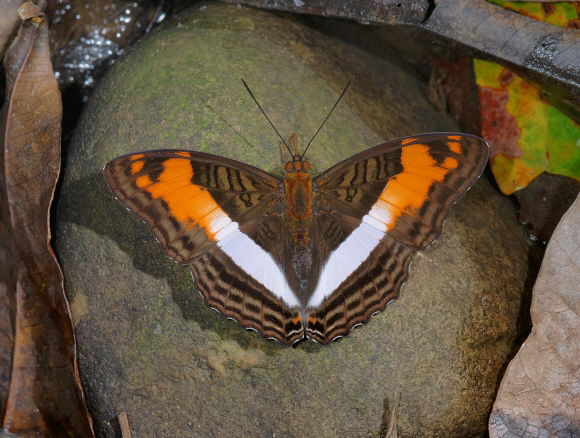|
Butterflies of
the Amazon rainforest
Capucinus Sister
Adelpha capucinus
WALCH, 1775
Family - NYMPHALIDAE
subfamily -
LIMENITIDINAE
Tribe - LIMENITIDINI
introduction
|
habitats |
lifecycle |
adult behaviour
Adelpha capucinus, Rio Madre de Dios, Peru
Introduction
There are 85 known species of
Adelpha,
all but one of which are confined to the neotropical region.
Adelpha
are characterised by having a distinctive marbled pattern overlaid on a
dark brown ground colour; and by the presence of a broad orange or white band on the
forewings. The hindwings of most species have a white median band.
While it is easy to recognise the genus, determining the individual
species
can often be very difficult, a problem exacerbated by misidentified or
mislabelled specimens in certain entomological books. The only reliable resource
for identification is the book "The genus Adelpha" by Keith Willmott, from which
this photograph was identified.
Accurate identification requires
careful examination of the configuration of orange markings in the subapical area
on the forewing. In most cases it is also essential to examine the patterning on
the undersides, by which means otherwise similar species can be
distinguished.
Adelpha capucinus
occurs from Venezuela to Bolivia.
Habitats
This
species
is found in primary rainforest east of the Andes, at altitudes
between sea level and about 1300m.
Lifecycle
Unknown,
but the following generalisations are applicable to the genus
Adelpha
:
The larval foodplants of
Adelpha
species are diverse, although the majority of
species feed on Rubiaceae, Moraceae, Urticaceae or Ulmaceae.
The
eggs of most species are white or pale green, and laid singly on the foliage of
the foodplants.
The
larvae are cryptically coloured and have 2 rows of conspicuous spines along
the back, with those on the first two segments enlarged and directed forward,
while the third pair are directed backward.
The
pupae, which are suspended by the cremaster, are in some species green or brown,
while others are entirely silver, and shiny. The pupae of some species are
decorated with numerous spikes and projections, and sometimes have very
prominent palpi.
Adult behaviour
Like most
Adelpha species this butterfly is usually seen singly or in small
groups.
Males can often be found in mixed Nymphalid aggregations imbibing
moisture on riverbanks or sunny forest tracks. They also feed at
dung, urine soaked soil and decomposing fruit on the forest floor;
and prefer to feed in dappled sunlight, avoiding exposed river
beaches.
|

